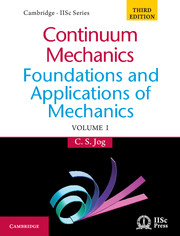3 - Balance Laws
Published online by Cambridge University Press: 05 August 2015
Summary
In this chapter, we derive the balance laws by requiring that the material volume, i.e., a volume that comprises a fixed set of particles, obeys the axioms of mass conservation, balance of linear and angular momentum, and the laws of thermodynamics. The important point to note is that the choice of this material volume is arbitrary; for example, any arbitrary subset of a given material volume also constitutes a valid material volume to which the above axioms can be applied. The original statements of all the axioms are in integral form. Using the arbitrariness of the material volume yields a set of differential equations governing the field variables. The solution of these differential equations subject to appropriate boundary and initial conditions then defines the variation of each field variable with space and time.
In fluid mechanics, it is useful to derive balance laws for a control volume, which is a region of space where various flow quantities are observed. The control volume approach has the advantage that, under certain conditions, it is possible to calculate quantities such as the force exerted or the power generated or dissipated, simply by having the appropriate information at the control surface. However, the weakness of this approach is that we do not obtain the details of the various fields at every point within the control volume. For obtaining detailed information, we need to solve the governing differential equations subject to appropriate boundary and initial conditions.
As emphasized in Chapter 1, we write the governing equations in tensorial form, because then it is immediately evident that such equations are independent of the choice of coordinate system. Only while solving specific problems, we choose a particular coordinate system, and write the tensor equations in component form in that particular coordinate system.
- Type
- Chapter
- Information
- Continuum MechanicsFoundations and Applications of Mechanics, pp. 166 - 202Publisher: Cambridge University PressPrint publication year: 2015



